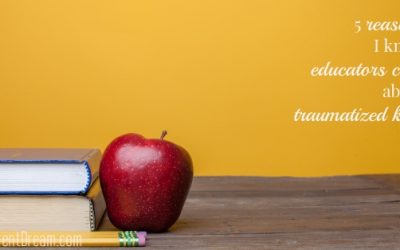Effective Treatment of PTSD in Children

Thank you so much for stopping by to read this article, which is the ninth in an ongoing series about PTSD in children. This post reviews several therapies that have proven highly effective in treating children who have experienced significant trauma or have been diagnosed with PTSD. As was mentioned in the third article in this series, one misconception about PTSD in children impacted by trauma is that they are damaged for life. In the past few years the creation of effective treatment methods has made that attitude less prevalent.
Treatment for PTSD in Very Young Children
Research done between 2000 and 2010 found that very young children who experience significant trauma may not suffer lasting effects if they receive immediate support from a trusted primary caregiver. Effective support contains 3 major elements. First, the primary caregiver must let the child know he or she believes the event was scary. Cuddling a child and saying, “That was so scary when the air bag popped out!” or “Your leg hurt when the nurse gave you that shot!” offers physical comfort and security and acknowledges the child’s experience. Second, caregivers must be patient after the initial validation. A young child needs reassurance over a long period of time. Caregivers need to allow time for babies and very young children to recover. Finally, caregivers who were traumatized along with their children must manage their own emotions. Doing so may be as simple as talking to a friend about their emotions or going for a walk. Or it may require seeking professional help.
Effective Trauma Treatments for PTSD in Children and Teens
Trauma-focused cognitive behavioral therapy (TF-CBT). The trauma-focused branch of cognitive behavioral therapy (TF-CBT) is amassing a body of research record about treating preschool-aged children through adolescents. This therapy is done by a trained clinician who talks to a child about traumatic experiences and monitors the child’s responses to determine the time and pace of therapy. The prevention of future trauma, developing resiliency in kids, and training parents to be agents of change are part of this therapy model. For children who are preverbal or nonverbal, parents are trained in trauma prevention and behavior management. Because this therapy is talk-based, it works best for children who were verbal at the time of the trauma.
To read the rest of this post, visit the Key Ministry blog, Church4EveryChild.
Part 1: Writing About PTSD Was Not on My Bucket List
Part 2: Childhood Trauma by Any Other Name Is Still Traumatic
Part 3: 10 Myths about PTSD in Children
Part 4: What Causes PTSD in Children
Part 5: A Look Inside the Brain’s Response to Childhood Trauma
Part 6: Why the Spotlight Is on PTSD in Children
Part 7: Childhood PTSD Symptoms in Tots, Teens, and In Between
Part 8: Why and How Childhood PTSD Is often Misdiagnosed
Part 9: Effective Treatment of PTSD in Children
Part 10: How to Prevent PTSD in Traumatized Children
Part 11: How Parents Can Advocate Effectively for Traumatized Children
Part 12: 4 Reasons Traumatized Kids Need Mentally Healthy Parents
Part 13: Clinging to Faith While Parenting Children with PTSD
Do you like what you see at DifferentDream.com? You can receive more great content by subscribing to the quarterly Different Dream newsletter and signing up for the daily RSS feed delivered to your email inbox. You can sign up for the first in the pop up box and the second at the bottom of this page.
By Jolene
Jolene Philo is the author of the Different Dream series for parents of kids with special needs. She speaks at parenting and special needs conferences around the country. She’s also the creator and host of the Different Dream website. Sharing Love Abundantly With Special Needs Families: The 5 Love Languages® for Parents Raising Children with Disabilities, which she co-authored with Dr. Gary Chapman, was released in August of 2019 and is available at local bookstores, their bookstore website, and at Amazon.
1 Comment
Submit a Comment
Subscribe for Updates from Jolene
Related Posts
I Am Here. You Are Safe.
I am here. You are safe. These 6 words make all the difference for Heesun Hall’s son when his PTSD caused by medical trauma leads to troubled sleep.
Educators Care about Traumatized Kids
This summer, I facilitated trauma training classes for more than 80 educators and realized something very heartening: educators care about traumatized kids.
The Hope Anew Disability Podcast
The Hope Anew Disability Podcast is the latest offering from Jonathan and Sarah McGuire. Learn who it’s for and what it’s about in this post.






Thanks for sharing this valuable info with us! Most people don’t think of children as ever having PTSD!